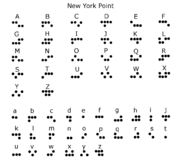
New York Point
Encyclopedia

Blindness
Blindness is the condition of lacking visual perception due to physiological or neurological factors.Various scales have been developed to describe the extent of vision loss and define blindness...
invented by William Bell Wait
William Bell Wait
William Bell Wait was a teacher in the New York Institute for the Education of the Blind who invented New York Point, a system of writing for the blind that enjoyed wide use in the United States before the Braille system was universally adopted there. Mr...
(1839-1916), a teacher in the New York Institute for the Education of the Blind. The system used three bases of equidistant points arranged in two horizontal lines with one, two, three or four points in each line ( : :: ::: or :::: ). The most common letters are assigned to the configurations with the fewest points.
New York Point competed with the American Braille system, which employed the Braille
Braille
The Braille system is a method that is widely used by blind people to read and write, and was the first digital form of writing.Braille was devised in 1825 by Louis Braille, a blind Frenchman. Each Braille character, or cell, is made up of six dot positions, arranged in a rectangle containing two...
base (an array of points 2 wide by 3 high). Embossed alphabets are relatively bulky, and New York Point's system of only two horizontal lines and principle of assigning common letters to characters with the fewest points were seen as advantages.
Wait advocated the New York System as more logical than either the American Braille or the British Braille systems, and these systems competed in what was known as the War of the Dots. Around 1916, writing was standardized to a system more closely corresponding to British Braille, chiefly because of the large amount of written material available in that system.
Wait also invented the Kleidograph, a typewriter
Typewriter
A typewriter is a mechanical or electromechanical device with keys that, when pressed, cause characters to be printed on a medium, usually paper. Typically one character is printed per keypress, and the machine prints the characters by making ink impressions of type elements similar to the pieces...
with twelve keys, for embossing the New York Point system on paper, and the Stereograph, for creating metal plates to be used in printing books for the blind.
External links
- An autobiography of William Bell Wait and discussion of the invention of New York Point.
- Further biographical information on William Bell Wait, including the New York Point alphabet
- Robert B. Irwin's As I Saw It, 1955, gives a history of the "War of the Dots" that ultimately led to the adoption of the English form of the braille literary code in the United States.
- A Look Back, published in JVIB, March 2006, documents the War of the Dots.

